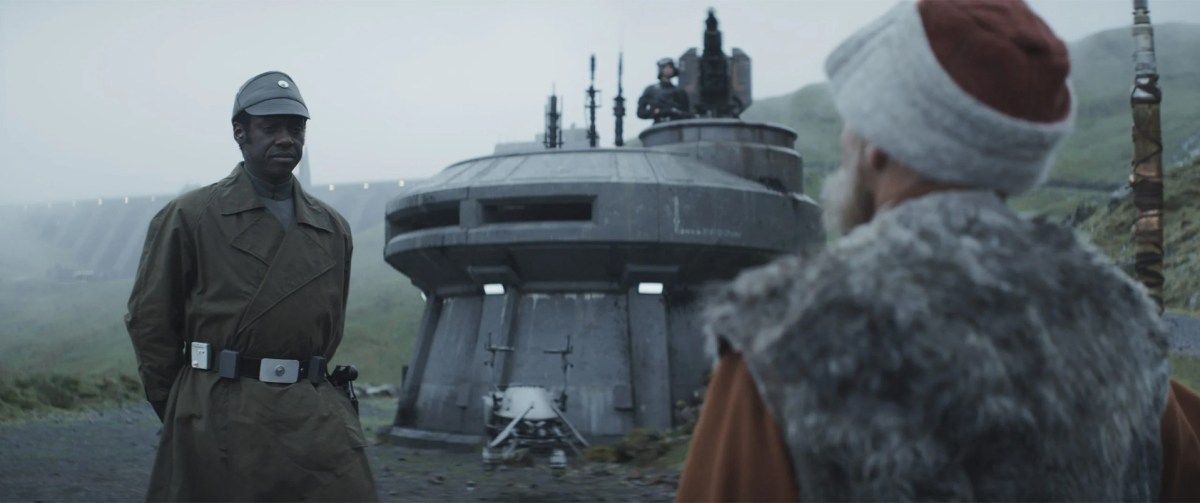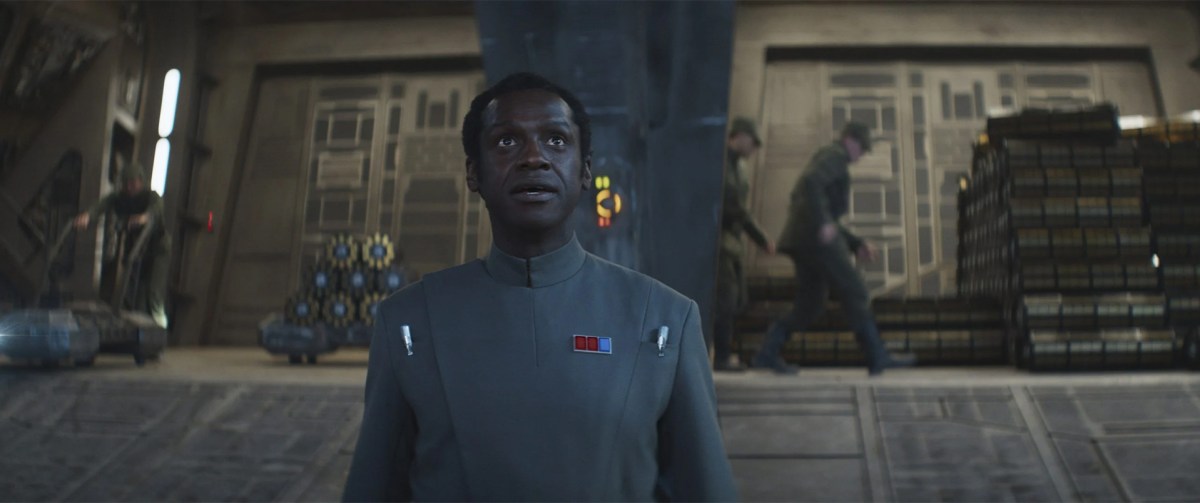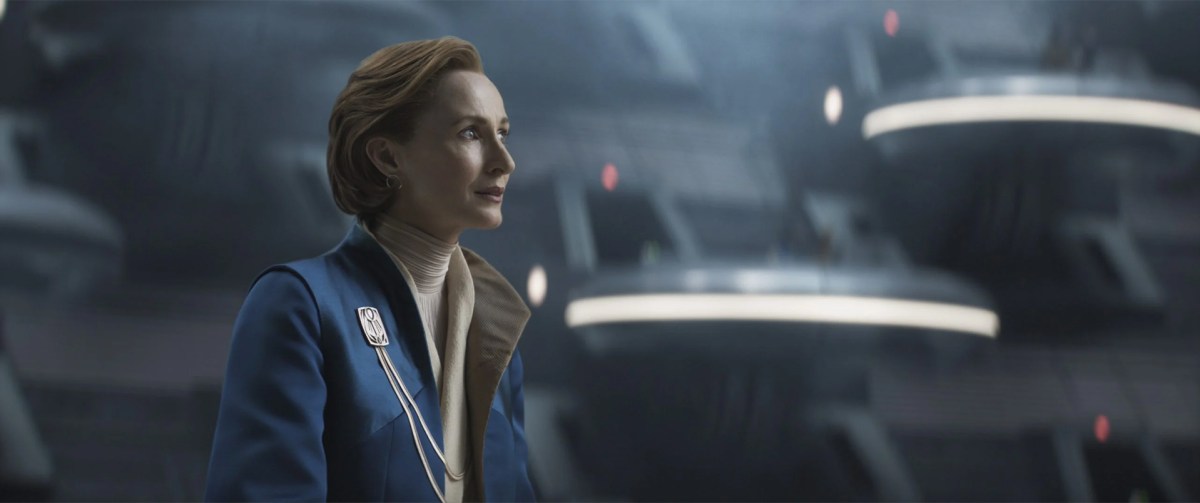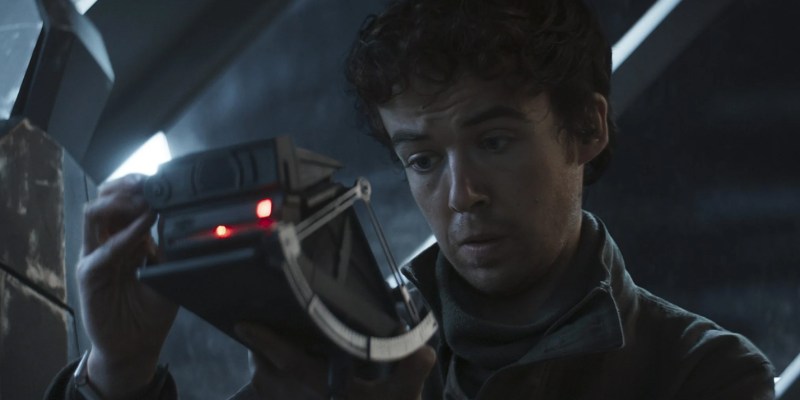This discussion and review contains spoilers for Andor episode 6, “The Eye.”
“The Eye” is a spectacular piece of television and an amazing piece of Star Wars.
The culmination of writer Dan Gilroy and director Susanna White’s three-episode arc, “The Eye” is a masterclass in escalating tension. It is a tightly constructed suspense machine, one that delivers payoffs both nerve-shredding and effortless. It is a reminder of what Star Wars can do and the product of a creative team working at the peak of their creative power. There is tremendous craft on display, particularly Luke Hull’s production design, John Gilroy’s editing, and Frank Lamm’s cinematography.
In particular, it is worth singling out the score from Nicholas Britell. Britell seems an unusual fit for Star Wars. He is best known on television for his Emmy award-winning work on Succession and in film for his Oscar-nominated collaborations with Barry Jenkins on Moonlight and If Beale Street Could Talk. Britell seems as unconventional a choice for a Star Wars streaming series as showrunner Tony Gilroy himself. This is probably part of why his work on Andor feels so revelatory.
Britell finds a way to score Star Wars that fits the material without feeling completely beholden to the work of John Williams. Britell’s work on Andor is striking, particularly in “The Eye.” As the daring raid progresses, Britell’s score keeps pace. It continues to heighten, becoming the beating heart of this high-stakes mission. Much like the show around it, Britell’s score manages to sound convincingly like Star Wars while still feeling like a fresh and dynamic approach.
“The Eye” is packed with memorable beats and lines, images and choices that linger after the closing credits. It’s so tense that Commandant Jayhold Beehaz (Stanley Townsend) has a heart attack in the middle of a standoff. There are countless pump-the-fist moments, from the shot of pilots climbing into their fighters to Lieutenant Gorn (Sule Rimi) acknowledging to Beehaz that he may be hanged for his crimes. “Seven years serving you?” he replies without missing a beat. “I deserve worse than that.” Gorn goes hard.

“The Eye” is pure spectacle. It is also an episode about spectacle. In particular, the episode’s big recurring motif is about the importance of making people pay attention — of forcing them to watch. After all, the clue is in the title. In some ways, “The Eye” feels like part of a broader cultural conversation about the power of spectacle, dovetailing neatly into Jordan Peele’s work on Nope. “The Eye” is about creating something so powerful that people cannot look away.
This is obvious even in the structure of the episode. Both “Aldhani” and “The Axe Forgets” were deliberately fractured narratives, structured like episodes of Game of Thrones or The Rings of Power. These stories cut between characters scattered across the universe, creating a sense of a truly fragmented galaxy. These weren’t single cohesive narratives, but instead smaller snippets of a bigger picture, waiting to be forced into a larger shape.
“The Eye” adopts that larger shape. Up until its closing scenes, “The Eye” is tightly focused on Vel Sartha’s (Faye Marsay) mission to steal the Imperial payroll. The other elements of “Aldhani” and “The Axe Forgets” are forgotten and marginalized. Syril Karn (Kyle Soller) doesn’t appear at all. Supervisor Dedra Meero (Denise Gough), Mon Mothma (Genevieve O’Reilly), and Luthen Rael (Stellan Skarsgård) only appear fleetingly in the episode’s final moments, reacting to the raid.
“The Eye” is about creating something so big that the galaxy has to open its eyes. This is established as early as the opening conversation between Karis Nemik (Alex Lawther) and Cassian Andor (Diego Luna). “The empire has no moral boundaries. Why should we not take hold of every chance we can?” Nemik asks. “Let them see how an insurgency adapts.” When Andor replies that the Empire will never learn, Nemik replies, “Perhaps they’ll think differently tomorrow.”

Andor consistently argues that the Empire succeeds by fragmenting its adversaries, constructing individual traps that prevent their subjects from seeing the big picture. Commandant Beehaz boasts as much to Colonel Petigar (Richard Katz), talking about overwhelming the subjugated Aldhani with “alternatives.” He explains, “You put a number of options on the table and they’re so wrapped up in choosing, they fail to notice you’ve given them nothing they thought they wanted at the start.”
Beehaz talks about the pilgrimage that the Aldhani take up to the valley, to observe their religious festival. The Empire has placed “Comfort Units” along the route to break up the march. What began as 500 people marching is efficiently reduced to a group of about 60. This limits the possibility of rebellion. If only a handful of people are able to make that ascent and to look up at the stars, then only that handful of people can realize what is truly possible.
In both a literal and figurative sense, “The Eye” is built around the idea of ascent, of rising above the chaos and the noise. The Aldhani Chieftain (David Hayman) leads his followers on a trip up into the highlands. Beehaz boasts about how the Empire sits “above the stench” of the indigenous population. Nemik’s command to Andor during their escape is a simple leap of faith: “Climb.” The Aldhani need to look up to witness the miracle. It’s a cohesive thread that runs through the episode.
It’s also a clever way of tying Andor back into Rogue One. After all, the last command that K-2SO (Alan Tudyk) would give to Andor was also “climb.” The climax of Rogue One is about Andor ascending a tower to send out a signal that will help the Rebellion deal a crippling blow to the Empire, a moment that galvanizes the Rebellion and bloodies the Empire’s nose. It’s clever to see that imagery mirrored in Andor’s first true mission as a rebel, prefiguring his last.

“A surprise from above is never as shocking as one from below,” Nemik remarked back in “The Axe Forgets.” There is a sense that he was, to quote Andor, “half-right” there. The important thing is to come out on top. The team marches into the base at ground level, with Sartha and Cinta (Varada Sethu) sneaking in under the surface of the lake. However, they escape through ascent. They fly away. They are, in essence, elevated through this action.
“The Eye” returns time and again to the importance of witnessing. It isn’t enough that the team steals the credits; their act of defiance must be recorded and spread. Nemik dies during the raid, but he lives on in the manifesto that Sartha passes to Andor. Nemik also boasts about the importance of the radio to the mission. “It’ll carry on working long after everything else has fried,” he says. Indeed, the raid is almost spoiled by Corporal Kimzi (Nick Blood) scanning radio frequencies.
It makes sense that this top-secret mission is carefully integrated into the Aldhani festivities. Indeed, throughout “The Eye,” dialogue is constructed in such a way that characters who think they are talking about the festival are also talking about the heist. “It really is something to see,” Beehaz boasts to Petigar. “Quite the celestial spectacle.” As Gorn does one last check, a younger officer asks him, “Has it started?” Gorn replies, with no small dramatic irony, that it certainly has.
There is a sense that this is a truly seismic event. Things are not the same afterwards. This is true even within the group. “Everyone has their own rebellion,” Sartha advised Andor in “The Axe Forgets,” a line that gets an ironic reprise in “The Eye” when Arvel Skeen (Ebon Moss-Bachrach) suggests that he and Andor simply steal the payroll that Sartha just stole. When Andor asks whether Skeen is a rebel, Skeen replies, “I’m a rebel. It’s just… me against everybody else.”

That line makes sense in the context of both “Aldhani” and “The Axe Forgets,” which suggested that there are any number of individual struggles against the Empire. However, after the events of “The Eye,” that logic is no longer convincing. Andor executes Skeen on the spot, refusing to even seriously consider his offer to abandon Sartha and split the spoils. It’s a testament to both Diego Luna’s performance and Dan Gilroy’s scripting that this act is ambiguous.
There are a couple of ways of reading Andor’s choice, depending on how cynical one is. Did Andor kill Skeen because Skeen betrayed Sartha and Nemik? Is Andor beginning to truly believe in the cause? Or was the choice more pragmatic? Did Andor kill Skeen because he knew that Skeen was just as likely to betray him as soon as the two of them were safely away? “The Eye” provides no clear answer, and it is better for that. This is just well-written Star Wars.
Of course, there is a somewhat metafictional aspect to all of this. “The Eye” is effectively about the Rebellion grabbing and holding the audience’s attention. In pre-release interviews, Tony Gilroy talked about how one of the appeals of getting to work on Star Wars was that franchise media “has the added advantage of an audience.” Andor is in some ways a show about making Star Wars, and it seems that Sartha and Rael also understand the Rebellion needs the “advantage of an audience.”
“The Eye” is a powerhouse piece of Star Wars for the audience watching at home, but there is a sense that it is a similar experience for the inhabitants of the larger gallery. Mothma watches the information trickle through the Senate. Rael hears about the attack’s success not through the old radio in the back of the store, but in idle chatter from a customer (Joseph Arkley). Things will never be the same. The narrative has been shifted.
With due respect to Nemik’s manifesto, it feels like an appropriate time to quote another revolutionary poet: “All changed, changed utterly: A terrible beauty is born.”
